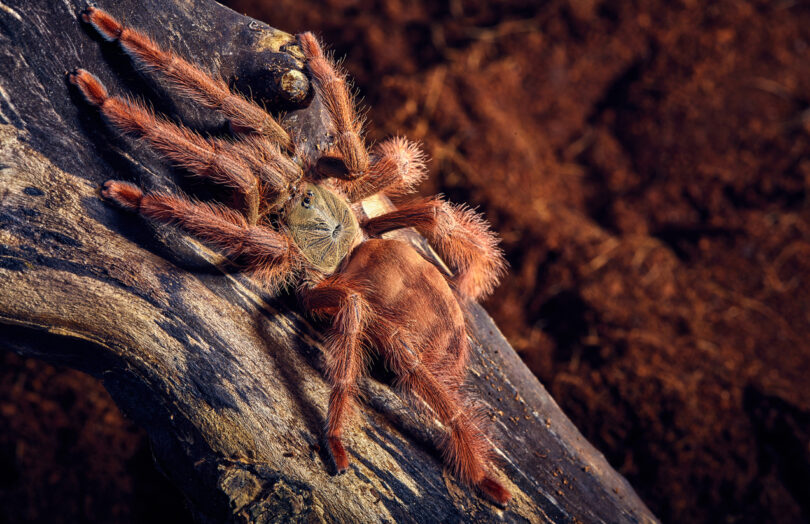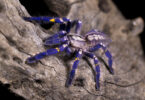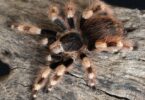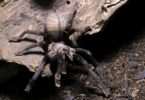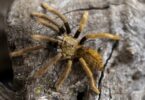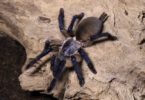Having trouble understanding the enigmatic world of tarantulas? The Pseudoclamoris gigas (ex. Tapinauchenius gigas), also known as the Orange Tree Spider, is a fascinating creature with vibrant appeal. Dive into this blog, and we’ll unravel the secrets of its habitat, behavior, and care—turning confusion into clarity for you.
Get ready to be captivated..
Description of Pseudoclamoris gigas
Meet the Pseudoclamoris gigas, an arresting arboreal tarantula with a fiery orange demeanor that stands out like a vibrant flame in the lush greenery of French Guiana. Revered for its stunning appearance and captivating behavior, this species is more than just a pretty face — it’s an arachnid aficionado’s dream.
Size and Life Span
The Pseudoclamoris gigas, or the Orange Tree Spider, is a tarantula with a leg span of about 6 inches. Girls get bigger than boys – think of them as the giants in their spider world! They wear an exoskeleton, kind of like armor that shields them as they grow.
Now, these eight-legged creatures don’t just look impressive; they’ve got years to show off too. How many? Well, if you’re a female Orange Tree Spider, you could be hanging around for up to a 15 years!
Tarantulas are tough and this one’s no exception – it’ll spend its years hunting prey. Sure enough, living for 15 years means lots of time spent waiting on tree branches in your cozy web home before surprising an unlucky meal.
Habitat
So, these orange tree spiders like to live way up high. They find homes in the trees of warm forests. Think of them as little acrobats swinging from branch to branch in a place where the trees touch the sky – that’s their playground!
They prefer spots above ground, away from most dangers below. These spiders make their webs among leaves and branches, creating cozy hideouts. You could say they’re forest dwellers with a love for tree-top life! In their world, being up high is the best way to stay safe.
Behavior and Venom Potency of Orange Tree Spider
The bigger the spider gets, the more it may change how it act. Small ones might act one way while big ones show off other skills.
It’s worth remembering that, although it rarely shows aggression, it is very fast and agile, especially younger individuals. During feeding or rehousing attempts, they may escape and be challenging to locate. In such cases, it’s advisable to look for our lost tarantula on the ceiling in the evening hours.
Even though these spiders have strong venom for catching food, it’s not a big worry for people. Their toxic bite is made to work well against small creatures they eat, not humans or big animals.
So if you see one, know that it’s dangerous mostly to its prey!
Pseudoclamoris gigas Enclosure Requirements
Crafting the perfect home for your Pseudoclamoris gigas isn’t just about aesthetics—it’s crucial for their wellbeing. Let’s dive into the essentials of creating a habitat that mirrors their natural tropical haven, ensuring these arboreal creatures thrive under your care.
Ideal Terrarium Set-Up
Setting up the ideal home for a Pseudoclamoris gigas, also known as the Orange Tree Spider, is important. This ensures they stay healthy and can behave like they would in the wild.
- The terrarium must be arboreal because these spiders love to climb. They need a lot of vertical space.
- Choose an enclosure that’s at least four times taller than the spider’s size to let it move up and down freely.
- Add branches or pieces of cork bark for the spider to grab onto and make its web.
- Ensure good air flow with enough holes but make sure the spider can’t escape.
- Keep humidity right with regular misting, which helps mimic their natural environment.
- The terrarium should stay about 80 degrees Fahrenheit, warm like where they come from.
Humidity and Temperature Necessities
Getting the humidity and temperature just right is key for a happy Pseudoclamoris Gigas. Imagine it like setting up their own little bit of the jungle at home. Keep moisture levels around 80 percent – not too wet, not too dry.
This makes sure they have enough water in the air to stay healthy (young individuals are sensitive to dehydration).
For temperature, think warm and stable; aim to keep their home around 80°F. Watch out though – good airflow is a must-have so things don’t get stuffy! With those ideal conditions, these orange beauties will thrive.
Next up: getting into how these spiders make more little spiderlings..
Breeding Pseudoclamoris gigas
Breeding Pseudoclamoris Gigas is similar to how Psalmopoeus spiders are bred. During mating, care must be taken because sometimes the female may go after the male even if they have mated successfully.
After mating, the female makes an egg sac. This sac stays in a warm place at about 28°C for around one month.
Expect close to 100 little spiders from one egg sac—quite a crowd! These spiderlings start small but grow quickly with proper spider care. It’s important to keep their home just right with humidity levels up and water droplets available on webbed surfaces so they can thrive.
Conclusion
So, that’s the scoop on Pseudoclamoris gigas—the amazing Orange Tree Spider. These creatures bring a bit of tropical flair with their bright orange color and arboreal living. Remember, if you’re thinking about keeping one, their home needs to be just right—with proper humidity and warmth.
Plus, respect their space; they’re wild at heart! It sure is intriguing how Mother Nature cooks up such interesting critters—don’t you think?.
FAQs
1. What do Orange Tree Spiders eat?
A Pseudoclamoris gigas prefers fast-moving insects, with Turkish roaches being the best for this.
3. How big do Pseudoclamoris gigas get?
Around 6 centimeters in body length and 15 centimeters in leg span.
4. Can I keep an Orange Tree Spider as a pet?
Pseudoclamoris gigas – suitable as a first tarantula, just need to ensure not to dehydrate it in the initial stages of development, and it will reciprocate with very rapid growth, faster than most tarantulas.

